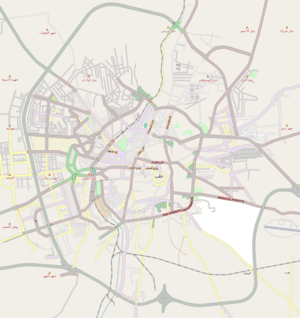Aleppo Artillery School massacre
| Aleppo Artillery School massacre | |
|---|---|
| Part of Islamist uprising in Syria | |
 Artillery School location | |
| Location |
|
| Date | 16 June 1979 |
| Target | Syrian Army cadets |
Attack type | Execution |
| Deaths | 50-83 |
| Perpetrators | Ibrahim el-Youssef, ʿAdnan ʿUqla, Syrian Muslim Brotherhood |
The Aleppo Artillery School massacre was a massacre of Syrian Army cadets by members of the Muslim Brotherhood, which was part of the Islamist uprising in Syria, 1976–1982.
Course of Events
The massacre occurred on June 16, 1979, in the Ramouseh district of the city of Aleppo, Syria. An officer on duty, Ibrahim el-Youssef, and members of the Syrian Muslim Brotherhood calling themselves the Fighting Vanguard (at-Tali’a al-Muqatila) and led by ʿAdnan ʿUqla, massacred between 50 and 83 Alawi cadets in the Aleppo Artillery School.[1][2][3] The duty officer in charge of the school called Alawite cadets to an urgent morning meeting in the mess hall of the school; when they arrived, he and his accomplices opened fire on the unarmed cadets with automatic weapons and grenades.[4] The incident marked the beginning of full scale urban warfare of the Syrian Muslim Brotherhood against that ruling Alawites.[5]
On June 22, the Syrian interior minister, Adnan al-Dabbagh, accused the Muslim Brotherhood of the massacre. Although the principal targets were members of the Alawite sect, the Syrian Minister of Information, Ahmad Iskander Ahmad, stated that the murdered cadets also included Christians and Sunni Muslims.[6] In a statement distributed on June 24, the Muslim Brotherhood organization denied that it had any prior knowledge of the massacre nor involvement in it.[6] It also accused the Syrian government, then led by the Alawite President Hafez al-Assad, of trying to tarnish the image of the Muslim Brotherhood, speculatively because it was influential among the Syrian public.
The Syrian government responded by sentencing to death an estimated 15 prisoners belonging to the "Islamic resistance movement", all of whom were accused of being Iraqi agents. Following the massacre, terrorist attacks became almost a daily occurrence, particularly in Aleppo and other northern cities. The government usually attributed these attacks to the Muslim Brotherhood, but as the armed resistance gained wider popular support and other, loosely defined, armed groups appeared, it became difficult to determine the extent of the Brotherhood's involvement.[7]
See also
References
- ↑ The Assad Era Thomas Collelo, ed. Syria: A Country Study. Washington: GPO for the Library of Congress, 1987.
- ↑ Syria's Islamist Movement and the 2011-12 Uprising ORIGINS volume 5 issue 10 Archived June 22, 2012, at the Wayback Machine.
- ↑ From Hama to Hamas: Syria's Islamist Policies inFocus SPRING 2009 • VOLUME III: NUMBER 1, Jewish Policy Center
- ↑ http://www.shrc.org/en/?p=19785
- ↑ Wiedl, Kathrin Nina (2006). The Hama Massacre: Reasons, Supporters of the Rebellion, Consequences. GRIN Verlag. p. 8. ISBN 3-638-71034-3. Retrieved 2013-03-17.
- 1 2 "The Massacre of the Military Artillery School at Aleppo - Special Report | 2002 Reports". SHRC.org. Retrieved 2013-03-17.
- ↑ Carré , 135-7.